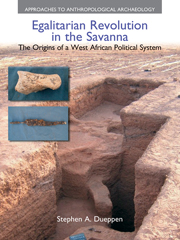Book contents
- Frontmatter
- Dedication
- Contents
- List of Figures
- List of Tables
- Acknowledgments
- 1 Decentralization and the Evolution of Egalitarian Behaviors in Sedentary Societies
- 2 Ancient Villages in the Niger Bend: Context and Methods for Exploring the Voltaic Region
- 3 Ethnographic Perspectives on Western Burkina Faso: A Survey
- 4 Kirikongo: An Introduction to the Site, the Setting, and the Research Design
- 5 The West African Environmental Setting: Kirikongo in Ecological Context
- 6 Stratigraphies and Depositional Episodes: The Excavations
- 7 Relative Chronology: Ceramics
- 8 Community Growth at Kirikongo: The Spatial and Temporal Setting
- 9 Early Sedentary Life in the Voltaic Region: Defining a ‘Voltaic Tradition’
- 10 Craft Production at Kirikongo: The Origins, Development and Reinterpretation of Specialization
- 11 Herding, Farming, and Ritual Sacrifice: The Economy from Kirikongo
- 12 Death and Ritual Objects at Kirikongo: House-Based Social Differentiation
- 13 Archaeological Patterns and Social Process: Reconstructing Changing Life at Kirikongo
- 14 Land, Spiritual Power, and Gerontocracy: An Exploration of the Roots of Egalitarian Revolution in the Western Voltaic Region
- 15 Hierarchy and Egalitarianism within the Niger Bend: Revolution and the Triumph of Communalism
- Bibliography
- Index
5 - The West African Environmental Setting: Kirikongo in Ecological Context
- Frontmatter
- Dedication
- Contents
- List of Figures
- List of Tables
- Acknowledgments
- 1 Decentralization and the Evolution of Egalitarian Behaviors in Sedentary Societies
- 2 Ancient Villages in the Niger Bend: Context and Methods for Exploring the Voltaic Region
- 3 Ethnographic Perspectives on Western Burkina Faso: A Survey
- 4 Kirikongo: An Introduction to the Site, the Setting, and the Research Design
- 5 The West African Environmental Setting: Kirikongo in Ecological Context
- 6 Stratigraphies and Depositional Episodes: The Excavations
- 7 Relative Chronology: Ceramics
- 8 Community Growth at Kirikongo: The Spatial and Temporal Setting
- 9 Early Sedentary Life in the Voltaic Region: Defining a ‘Voltaic Tradition’
- 10 Craft Production at Kirikongo: The Origins, Development and Reinterpretation of Specialization
- 11 Herding, Farming, and Ritual Sacrifice: The Economy from Kirikongo
- 12 Death and Ritual Objects at Kirikongo: House-Based Social Differentiation
- 13 Archaeological Patterns and Social Process: Reconstructing Changing Life at Kirikongo
- 14 Land, Spiritual Power, and Gerontocracy: An Exploration of the Roots of Egalitarian Revolution in the Western Voltaic Region
- 15 Hierarchy and Egalitarianism within the Niger Bend: Revolution and the Triumph of Communalism
- Bibliography
- Index
Summary
Kirikongo is located in the Mouhoun Bend, a region shaped by the long-term movements of the Mouhoun River, the largest permanent river in Burkina Faso. This area is today in the dry savanna, and its ecology is influenced by the extreme seasonality of rainfall. While the geologic base creates soils that are generally nutrient poor, the Bend is a particularly favored area for rainfall, with a high average for its latitude and minimized extremes. During Kirikongo's occupation, climate change periodically increased or decreased the amount of forest cover in the proximity of the site. This chapter presents the environmental context (geologic, hydraulic, climatic, and vegetative) of Kirikongo and neighboring regions within the framework of the dynamic West African savanna.
The Geologic Setting for the Region
West Africa's basement is an old and stable shield known as the West African Craton (McIntosh 2005). The relief that is seen in the region is the result of tectonics that created uplift at the coasts (e.g. the Guinea Highlands) and downward movements in the interior (e.g. the Taoudenni Basin) (Grove 1985b). This process has been accompanied by erosion of highlands and intermittent sedimentation in basins and troughs. Weathering has created a series of soil-types and lateritic duricrusts that vary in depth and character from region to region (Sattran and Wenmenga 2002). The resulting landscape is an ancient, flat, highly eroded and weathered surface, with large rivers descending from coastal highlands or high plateaus into interior alluvial basins and emptying into the Atlantic Ocean.
Western Burkina Faso is underlain by two major African geologic formations and the Mouhoun Bend is located near the border between them (Figure 5.1).
- Type
- Chapter
- Information
- Egalitarian Revolution in the SavannaThe Origins of a West African Political System, pp. 70 - 82Publisher: Acumen PublishingPrint publication year: 2012



